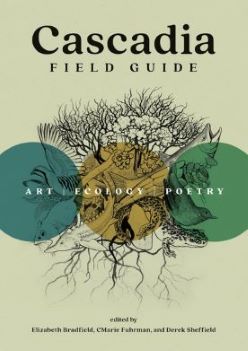The Cascadia Field Guide offers a wonderful introduction to a dynamic region.

I didn’t know what to expect when I saw Cascadia Field Guide in a Seattle bookstore, but what I found was a delightful reintroduction to a bioregion that extends from southeast Alaska down to Northern California and as far east as Idaho and Montana.
Although I spent most of my formative years in this area (I was born and raised in Anchorage, Alaska, just outside the Cascadia map, went to college in Salem, Oregon, and worked in Portland), I had a primarily urban relationship with the region. I spent most of my time there in small cities, dreaming about moving to larger cities. Yes, I went on hikes and bike rides, but I never bothered learning the names of flora and fauna. Aside from the most obvious things (spruce, birch, banana slug, etc.), I couldn’t have told you what was what.
Only when I began writing about the West (in TreeVolution and City of Dancing Gargoyles) did I realize how much I didn’t know about the place I was supposed to know intimately. Out of all the books and apps I’ve since used to catch up, Cascadia Field Guide has by far been the most engaging resource. Editors CMarie Fuhrman, Elizabeth Bradfield, and Derek Sheffield describe it as a “literary field guide” purposefully “turning STEM into STEAM.” They write in its introduction:
“Instead of species, we like the term being to refer to our neighbors. Whereas species feels dry, dusty, and objectifying, being feels vital and full of agency. We are Human beings living among Bird beings and Plant beings and so forth.”
The capitalization here is not mine but theirs. To those for whom this might seem a little woo-woo, don’t turn away quite yet. The book’s approach is artistic but down-to-earth.
The guide is divided into 14 sections corresponding to specific ecosystems, including Tidewater Glacier, Muskeg, Temperate Rainforest, and Urban Shore. Each begins with a description of that environment before featuring distinctive plants and animals of the area. Each environment, plant, and animal is explored in three ways: 1) field notes outlining its characteristics, 2) a poem by a Cascadian poet, and 3) an illustration by a regional artist.
What strikes me about the collection is its accessibility. The field notes aren’t the usual dry fare of facts and measurements. They’re vivid and relatable. This is how we meet the northern spotted owl:
“It’s night. You’re in the woods. Shush of wind through needles. Patting rain. Then, improbably, what sounds like someone blowing on a stem of grass trapped between their thumbs, and echo of a farmer’s rising Soooo-ee!”
The opening paragraph on the mountain goat demonstrates the guide’s refreshing mix of information, local custom, and wonder:
“All fluff and bright white, they cling to the edge of a precipice like a snagged cloud, causing us to hold our breath even as they maneuver deftly with one or two kids in tow. Mountain Goat dons a coat that grows double layers in winter and is shed in summer. This jettisoned fur has long been collected for ceremony and woven into Chilkat blankets admired internationally for their beauty and uniqueness. In the Montane [ecosystem], it is said that to find a tuft of Goat fur is to have luck on the mountain.”
The poems are a pleasant surprise. I admit I was bracing for a mix of inaccessibly austere and hyperbolic, idealized verse, but I was delighted by the carefully observed yet approachable work I encountered. Sierra Nelson’s “Blue Orchard Mason Bee” begins with a clever human/bee comparison:
“The mason bee of my 20s
takes herself out to a disco and brings herself home again.
Goes wild in the orchard, 2,000 blooms, but dances
just to please herself, belly yellow with pollen.”
Robert Bringhurst’s “Song of the Summit” captures the sensation of cresting a mountaintop:
“The difference is nothing you can see — only
the dressed edge of the air
over those stones, and the air goes
deeper into the lung, like a long fang,
clean as magnesium.”
And following an epigraph from Chief Seattle, editor Fuhrman’s “Prophecy” reveals the human souls inside trees:
“You must know, too,
because every autumn
Larch celebrate their abundance
with potlatch
and give away their summer gold.
When you see
the bare limbs and spine
you will also see the real people,
to which Coyote taught
that survival comes
in shades of brown.”
The illustrations display a broad range of artistic interpretations — from the fine lines of a realistic slug, to a pointillist brown bear, to a woodblock-print trout — allowing readers to visualize flora and fauna while experiencing a wide range of Cascadian art.
This book will teach you a mnemonic device for remembering the five kinds of salmon that run Cascadia’s rivers, and how to tell whether you’re looking at an unusually big crow or a full-on raven. It celebrates the species that revitalized the ashy aftermath of the Loowit (Mount St. Helens) eruption of 1980. It also shares Indigenous ways of knowing and interacting with the wild things of Cascadia, noting traditional names, stories, and culinary and medicinal uses for the plants and animals in each region. This valuing of Indigenous wisdom is consistent throughout the book, down to a subsection at the end on “First People and Traditional Ecological Knowledge.”
Whether you’re planning a visit or you live here and want to gain a deeper understanding of the region, Cascadia Field Guide makes learning about it a rewarding and enjoyable endeavor.
Tara Campbell is a writer, teacher, Kimbilio Fellow, and fiction co-editor at Barrelhouse Magazine. She teaches flash fiction and speculative fiction, and is the author of a novel, two hybrid collections of poetry and prose, and two short story collections. Her sixth book, City of Dancing Gargoyles, is forthcoming from Santa Fe Writers Project (SFWP) in fall 2024.

